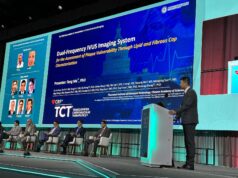
The question of early intervention among patients with severe aortic stenosis but no symptoms stood at the heart of two of the most significant trials presented at TCT 2024 (27–30 October, Washington, DC, USA).
If EARLY TAVR prompted some to conclude that, instead of waiting for aortic stenosis symptoms to progress, physicians now have the evidence to justify an early intervention through transcatheter aortic valve implantation (TAVI), findings of the EVOLVED trial offer a more nuanced message.
Guidelines have long recommended valve replacement in patients with severe aortic stenosis, EVOLVED investigator Mark Dweck (University of Edinburgh, Edinburgh, UK) told TCT attendees, but only in those who have symptoms due to their valvular disease.
Dweck noted that assessing symptoms in elderly patients with multiple comorbidities can be challenging, prompting the question as to whether an earlier intervention—via either TAVI or surgical aortic valve replacement (SAVR)—could be warranted to improve outcomes among these patients.
EVOVLED, an international multicentre prospective randomised open-label blinded-endpoint trial, was conducted at 24 sites in the UK and Australia, involved patients with asymptomatic severe aortic stenosis and mid-wall myocardial fibrosis—a driver of left ventricular (LV) decompensation in aortic stenosis and a predictor of patient mortality—with cardiovascular magnetic resonance (CMR) used to determine the patients most likely to benefit from an early intervention.
A total of 427 participants were screened for inclusion in the trial, with 278 deemed eligible for CMR assessment. Of these, 113 were randomised to undergo early intervention, with the use of TAVI or SAVR determined by a heart team, and 111 received guideline-directed conservative management.
The median time-to-intervention was starkly different with a gap of roughly 15 months between the two groups, Dweck reported at TCT, standing at five months in the early intervention arm and 20 months in the routine care arm. This difference in the timing of the procedure did not result in a meaningful difference in outcomes for patients, with the trial’s primary endpoint, a composite of all-cause death or unplanned aortic stenosis-related hospitalisation, occurring in 18% of patients in the early intervention group and 23% of patients in the conservative treatment group, Dweck revealed.
Unplanned aortic stenosis-related hospitalisation was less frequent in the early intervention group, however, whilst New York Heart Association (NYHA) symptom class at 12 months also favoured the early intervention group. “In patients who underwent early intervention, symptoms did not change at 12 months, but in the patients who were in the routine care group, the symptoms deteriorated with worsening NYHA status at 12 months,” Dweck said.
The finding prompted the EVOLVED investigators to conclude that the principal benefit of early intervention appears to be in the reduction of unplanned hospitalisation and in preventing the development of limiting symptoms among this patient population.
“I personally think this will be a fairly nuanced conversation with the patient,” said Dweck, reflecting on the results, which were also published simultaneously in the Journal of the American Medical Association. “The patients that I see fall broadly into two categories: elderly patients who are feeling well and don’t want to have an intervention; and other patients that want to be more proactive, they are healthy and well and want to stay healthy and well, and they are happy to undergo a procedure earlier to maintain their health status. So, I think it will be a personalised decision for individual patients to make with their physicians.”










